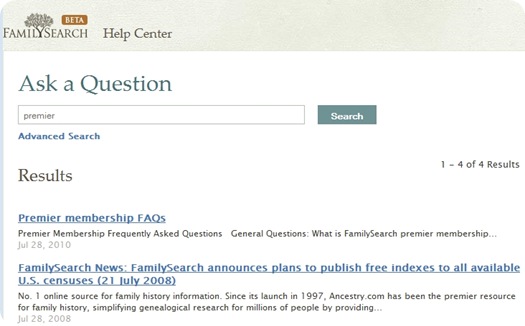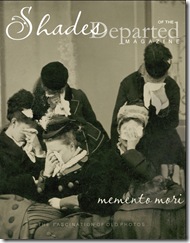Not everyone is aware that there is a “Premier” membership level on FamilySearch. Users with the Premier level membership can see all of the document images that are available on the site. Those without it, can see many, many images but some are reserved due to licensing and other contractual agreements.
Readers of Science Fiction novels will recognize the initials “TANSTAAFL”. They apply to FamilySearch as well.
“There Ain’t No Such Thing As A Free Lunch”
A great deal of money and time is required to acquire, license, digitize and host family history records. Someone has to invest up front and in the long term to bring the myriad of resources found on FamilySearch to us.
The primary investor is the Church of Jesus Christ of Latter-day Saints. They along with their partners in the project and folks like you and I who spend time as volunteers indexing records for inclusion on FamilySearch and related sites, round out the group.
A quick search for “Premier” on the Help page of FamilySearch provided a link to the Premier Membership Document that explains the program and the details of how we can obtain a “Premier” membership level ourselves.
The cost is certainly right. All we have to do is volunteer indexing. Earning 900 points every quarter gives us premier membership level access. That certainly makes sense. Investing about a half-hour of our time a week indexing the records that we use to help in our own ancestral quest is not only a ‘light fee’ but a ‘right fee’.
Indexing is easy and rewarding work. If you don’t already have login credentials for FamilySearch, you’ll need to create an account. The credentials extend to the Indexing section of FamilySearch.
Once you have an account, take 2-minutes to view the Test Drive of the Indexing tool and process. The site notes that No Special Skills are Required and that is the truth. Even the young folks in our family can easily run the indexing tool.
As a family history researcher, you’ll be used to reading the majority of the birth, marriage, death, census, church and other documents that you’ll see as you index.
The folks at FamilySearch and its partners already have and continue to Pay-It-Forward. Now it’s our turn. We all benefit from the Indexing, both now and in the future as Free Searchable Indexes are created that we can access in our PJ’s from home. The related images online are frosting on the cake.
Scroll to the bottom of the Indexing page to see the lists of Current, Completed and Future projects. You may also want to scroll through the historical records on the FamilySearch Beta site to get a flavor of how much indexing has already been completed and of the scope of this worldwide project.
Below is the Premier Membership document from FamilySearch that explains the program in detail.
I’m sure that we’ll see each other in the glow of our monitors as we spend a little time Indexing each week, doing the right thing for the right reason.
Premier Membership Frequently Asked Questions
General Questions:
-
What is FamilySearch premier membership?
-
Premier membership gives you access to view information (images and indexes) in some record collections on FamilySearch.org that might otherwise be unavailable or that you might otherwise have to pay to view. While FamilySearch does not charge for viewing this information, sometimes the record owners do.
-
-
Why does FamilySearch require premier membership to view these images?
-
Since we do not own all of the collections we publish, and some record owners require compensation to maintain their collection, this method enables more collections to be available for research. FamilySearch invests in private archives by preserving records and making these collections searchable.
FamilySearch and some of these archives have agreed by contract to allow access to those who make a significant contribution to this process. Without premier membership, you can usually search the indexes of these restricted collections; however, the images may not be freely available.
There are currently (as of June 2010) no collections that should require premier membership to view images. If you see records that require premier membership, please report that through the Feedback link.
-
-
How do I become a premier member? Are the benefits available to everyone?
- Yes, they are available to everyone through any of the following methods:
-
- Index records and earn 900 points within a calendar quarter.
- Belong to a sponsoring organization, such as The Church of Jesus Christ of Latter-day Saints or another company or society that sponsors FamilySearch.
-
Additional methods of contributing to FamilySearch may also qualify you for premier membership in the future.
-
In the future, family history centers located around the world will receive access to these restricted collections as well.
-
Why do members of The Church of Jesus Christ of Latter-day Saints receive premier membership status?
-
-
The Church of Jesus Christ of Latter-day Saints is the largest sponsoring organization of FamilySearch. Funded by the contributions of its members, The Church of Jesus Christ of Latter-day Saints invests in records and resources for family history research. Access to these resources is extended to the general community whenever possible.
-
-
What is the difference between being a “member” and being a “premier member?”
-
-
A member is anyone who has registered for a FamilySearch account. Some collections will require the researcher to at least be a member in order to view the information in the collection. A premier member is someone who has qualified based on the guidelines indicated above.
-
- Are there ever collections that a premier member cannot view?
-
-
Indexes for most collections will be available to premier members; however, some archives require that you view the images on their Web sites, and at times they may charge to view those images.
-
Indexing Specific Questions:
- When do I have to earn points to extend my membership?
- You must earn 900 points during a calendar quarter. The first quarter of the year is January through March; the second quarter is April through June, and so on.
- Once you earn 900 points, your premier status is immediately given for the rest of the current quarter and the next or following quarter. For example, if you index 900 points during July, you will earn premier membership that will last through December.
-
At the end of every quarter, the qualifying points are reset to zero, much like a cell phone plan that does not carry over minutes between months.
- Why is my expiration date “Never”?
-
If the expiration date is “Never,” you are a member of a sponsoring organization that does not need to earn points for premier membership.
-
- Why don’t the names indexed add up to what the points are?
-
Points are calculated from the number of names indexed, and they are given based on the difficulty of the record. Projects that are easier to index are generally worth fewer points, but at least one point is given for each name indexed.
-
- How much do I have to index to earn 900 points?
-
Indexing for approximately a half hour every week would usually earn the qualifying 900 points in a calendar quarter.
-
- Where do I find out how many points I currently have?
-
Sign in to the indexing Web site, and click My History on the left to see your statistics. It will inform you how many points you have and how many are required for you to attain premier membership; or if you are already qualified, it will tell you how many points you need to earn during this calendar quarter to retain your premier membership for the following quarter.
-
Calendar Quarter
Three (3) months of a year; the four quarters are defined as: January-March, April-June, July-September, October-December.
Collections
A group of similar records that is searchable on Record Search, such as England birth records, for example.
Restricted Collections
Collections in which either its index or images cannot be viewed without being a FamilySearch member or premier member.
Member
Someone who has registered for a FamilySearch account.
Premier Member
Someone who has qualified to gain additional access to record collections due to indexing 900 points in a calendar quarter or being a member of a sponsoring organization.










